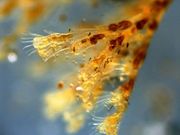Cnidaria
| Cnidaria |
|---|

|
| Scientific Classification |
| Classes |
Cnidaria is a phylum in the Kingdom Animalia of the biological classification system known as the Linnaean Taxonomic Hierarchy. The cnidarians were created on the fifth day of creation. "And God said, 'Let waters bring forth abundantly the moving creature that hath life, and fowl that may fly above the earth in the open firmament of heaven.' And God created great whales, and every living creature that moveth, which the waters brought forth abundantly, after their kind, and every winged fowl after his kind: and God saw that it was good. And God blessed them, saying 'Be fruitful, and multiply, and fill the waters in the seas, and let fowl multiply in the earth.' And the evening and the morning were the fifth day." (Genesis 2:20-23, NKJV)
The phylum cnidaria (silent c - pronounced /nai'deriə/) is also known as coelenterates. They are invertebrate animals that include the anemone, hydra, jellyfish, and coral. They are perhaps best known for being equipped with microscopic stinging cells called nematocysts. Every year people brush up against, touch or get stung by creatures in this phylum. Most of the time it causes skin irritation without serious injury, but in a few cases they have killed people. There are more than 9,000 different species and they can be found in all oceans and some even live in fresh water.[1]
Anatomy
The primary shape of the cnidarian is a sac with a gastro vascular cavity. It has one opening that acts as a mouth and an anus [2]. Typically it has tentacles at the opening of its mouth. They are really old some fossils have been found from the Precambrian age. It has radial symmetry.
Cnidaria are made up of two layers of cells - an external ectoderm (or epiderm) and an internal endoderm (or gastroderm). They are formed from two germ layers. Between the germ layers is the mesoglea. Muscle cells are found in the inner and outermost layers, they provide propulsion. There are two different forms in this phylum, the medusa and the polyp. The polyp sticks to the seabed, like an anemone. And the medusa is a free swimming jellyfish.[3]
They move by a decentralized nerve net and simple receptors. Several of the medusas possess rhopalia, complex sensory structures that include image-forming eyes with lenses and retinas. They also have a gravity sensing statolith like that of a vertebrate’s inner ear. The end of they're tentacles have nematocysts that thy use to catch prey and defend themselves. Nematocysts are special stinging cells.
The polyps tend to have a long, thin walled body. It attaches itself to rocks or other surfaces. The mouth of the hydra is surrounded by tentacles. The Medusa tends to be rounded, with a thick body that covers the mesoglea. It swims or is carried by the current with its mouth side down and its tentacles hanging.[4]
Reproduction
Cnidarians reproduce asexually and sexually depending on the type. Usually polyps will reproduce asexually, by budding. This is when an outgrowth from the body wall separates to form a new polyp or medusa. Medusa's primarily reproduce sexually; they produce sex cells called gametes. Then the sperm fertilizes the egg and then becomes a zygote. The zygote becomes a larva, which then develops into a medusa or polyp. Some medusas may form polyps by budding.
The life cycle of some jellyfish exhibit signs of both sexual and asexual reproduction. The male releases his sperm and the female releases her egg into the water. When the egg and sperm mix during sexual reproduction, a larva is formed and then clings to a rock or the sea floor and develops into a polyp. In asexual reproduction, the polyp divides into a colony of polyps that form a stack of saucers. Each one of these saucers eventually develops tentacles and swims off as an adolescent medusa, able to grow into an adult medusa and start the cycle over again.[5]
Ecology
Cnidarians can be found on sand, mud or hard ground. And sometimes you can find them in big colonies. A few of the cnidarians can cling to floating plant material in order to transport themselves. Most of the time you can find cnidarians on continental shelves. Some types with calcareous skeletons like to live on hard substrata, whereas types with a horny skeleton prefer muddy bottom.
Most cnidarians are marine organisms, but there are some that live in fresh water. The freshwater cnidarians are in the class Hydrozoa. These hydrozoans can be from 2 millimeters to 2 meters in diameter. Some hydrozoans can live in depths of about 8000 meters, but typically they stay in shallower waters of about 80-90 meters. A lot of the cnidarians are colonial. Each one of the cnidarians in the colony is genetically alike. Colonies grow in response to long-term environmental pressure.[6]
Related References
- Cnidaria Wikipedia
- CIGUATERA AND OTHER MARINE BIOTOXINSDistant Learning Lecture Notes Vanden Eden
- cnidaria encarta
- anatomy of medusa & polyps infoplease.com
- phylum cnidaria cox-internet.com
Gallery
Sea anemone
Class: AnthozoaBox jellyfish
Class: CubozoaSea anemone
Class Anthozoa







